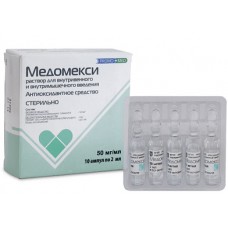Expiration date: 09/2026
The composition and form of issue:
Solution for in/in and/m injection. 1 ml contains:
Aethylmethylhydroxypyridini succinas 50 mg
auxiliary substances: sodium disulfite (sodium metabisulfite) — 1 mg water for injection to 1 ml
in vials of neutral glass for 2 or 5 ml (complete with a knife ampulnam or scarifier or not) in the contour plastic packages (pallets) or in packages contour 5 ampoules in a pack a cardboard 1 or 2 contour sells packaging (complete with a knife ampulnam or scarifier) or in cardboard boxes of 20, 50 or 100 packs of contour (complete with a knife ampulnam or scarifier). If you package vials with rings or points of fracture knives or metal ampoule do not invest.
Description pharmaceutical form:
Colorless or slightly yellowish transparent liquid.
Feature:
The drug Medomexi refers to heteroaromatic antioxidants.
Pharmacokinetics:
When I/m administration at a dose of 400-500 mg value Cmax of the drug in plasma is 2.5 to 4 mcg/ml, Tmax — 0,3–0,58 h. is Rapidly distributed to organs and tissues.
It is metabolized in the liver by glukuronirovania. Identified 5 metabolites, including 3-hydroxypyridine phosphate (formed in the liver and involvement of alkaline phosphatase breaks down into phosphoric acid and 3-hydroxypyridine) and glucuroconjugated one of the metabolites possess pharmacological activity.
T1/2 and the average retention time of the drug in the body when the/m introduction — of 0.7–1.3 h.
The drug is excreted in the urine mainly as metabolites (50% in 12 h) and in minor amounts (0.3% in 12 h) in an unmodified form. The most intensively excreted during the first 4 h after administration of the drug. Indicators of urine excretion of unchanged drug and metabolites have a significant individual variability.
Description pharmacological action:
Improves metabolism of brain tissue and blood circulation, microcirculation and blood rheology, reduces platelet aggregation. Stabilizes the membrane structure of erythrocytes and platelets. Has hypolipidemic effect, reduces total cholesterol and LDL.
The mechanism of action is due to its antioxidant and membrane-protective action. The drug inhibits lipid peroxidation, increases the activity of the enzyme superoxide dismutase, increases the ratio of lipid-protein in the cell membrane stabilizes the membrane of red blood cells, reduces blood viscosity, increases its fluidity. Modulates the activity of membrane-bound enzymes (calziinezawisimoy phosphodiesterase, adenylate cyclase, acetylcholinesterase), receptor complexes (benzodiazepine, GABA, acetylcholine) that enhances their capability to bind to ligands, contributes to maintaining the structural and functional organization of biological membranes, transport of neurotransmitters and improve synaptic transmission. Increases the content in brain dopamine. Causes increased compensatory activation of aerobic glycolysis and reducing the degree of oppression oxidizing processes in the Krebs cycle in hypoxia with an increase in the content of ATP and creatine phosphate, activation energosintezirutuyu functions of mitochondria, stabilization of cell membranes.
Has a wide range of pharmacological activity: improves the body's resistance to stress, exerts anxiolytic effects not accompanied by drowsiness and muscle relaxant effect has nootropic properties, improves memory, facilitates learning, improves concentration, mental performance and working capacity has anticonvulsant effect manifests antihypoxic properties of weakens the toxic effect of alcohol.
Indications:
- acute disorders of cerebral circulation by ischemic type (in the complex therapy)
- encephalopathy
- vegetative-vascular dystonia
- anxiety in neurotic and neurosis-like conditions
- light cognitive disorders of vascular origin
- age-related decline of cognitive functions in the elderly (disorders of memory, orientation, concentration)
- asthenic conditions (under the influence of extreme (stress) factors)
- withdrawal syndrome in alcoholism with the prevalence of neurosis and vegetative-vascular disorders
- acute intoxication antipsychotic drugs.
Contraindications:
- increased individual sensitivity to the drug
- acute hepatic and/or renal failure
- pregnancy
- breastfeeding (due to lack of data)
- the children's age.
Caution: allergic diseases in anamnesis.
Side effects:
For parenteral administration (especially in/in struino): dry mucous membranes of the mouth, metallic taste in mouth, feeling of heat spreading throughout the body, unpleasant smell, throat irritation and discomfort in the chest, feeling short of breath (usually associated with excessively high infusion rate and are short-term) long-term use — nausea, flatulence, sleep disturbances (drowsiness or sleep onset disorder).
Drug interactions:
The drug Medomexi working with psychotropic drugs increases the effect of benzodiazepine anxiolytics, antiparkinsonian funds and carbamazepine increases the effect of nitrates.
Method of application and dose:
The/m or/in (struino or drip).
Dose picked individually. During the infusion method of administration the drug should be diluted in 0.9% sodium chloride solution.
Begin treatment with a dose of 50-100 mg 1-3 times a day, gradually increasing the dose to produce a therapeutic effect. Jet the drug is administered slowly over 5-7 minutes, drip, with a speed of 40-60 drops per minute. The maximum daily dose not exceeding 800 mg.
In acute disorders of cerebral circulation used in the treatment in the first 2-4 days in/drip, with 200 to 300 mg 1 times per day, then — in/m to 100 mg 3 times a day. The duration of treatment is 10-14 days.
When dyscirculatory encephalopathy in the phase of decompensation should be prescribed the drug in/in struino or drip in a dose of 100 mg 2-3 times a day for 14 days, then — in/m to 100 mg 2-3 times a day for the next 2 weeks. For a course of prevention of dyscirculatory encephalopathy the drug is injected in/m in a dose of 100 mg 2 times a day for 10-14 days.
In mild cognitive impairment, age-related decline in cognitive functions and anxiety disorders the drug is administered I/m in a daily dose of 100-300 mg for 14-30 days.
Vascular dystonia, asthenic conditions, neurotic and neurosis-like States in m, 50-400 mg/day for 14 days.
When alcohol withdrawal syndrome the drug is administered in a dose of 100-200 mg/m 2-3 times per day or/drip in 1-2 times a day for 5-7 days.
In acute intoxication antipsychotic means the drug is injected in/in the dose of 50-300 mg per day for 7-14 days.
Overdose:
Symptoms: sleep disturbance (insomnia, in some cases, drowsiness). At/in the introduction — small and short-term (up to 1.5–2 h) increase in blood pressure.
Treatment: the development of insomnia (drowsiness) treatment usually not required — the symptoms disappear on their own within a day. In severe cases when insomnia is recommended to take sleeping pills. With excessive increase in blood pressure (after in/introductions) the appointment of antihypertensive drugs under the control of AD.
Special instructions:
Effects on ability to drive and use machines. During the period of treatment must be careful when driving and occupation of other potentially hazardous activities, require high concentration and psychomotor speed reactions.


